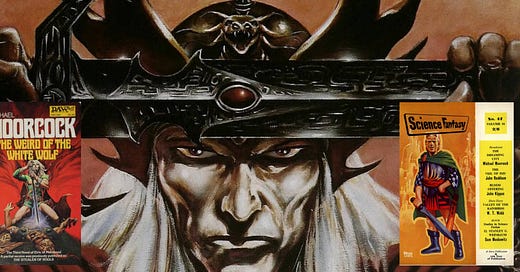1961: Elric of Melniboné
The influence and mythology of Michael Moorcock's infamous antihero and his swinging sixties mirror image
“As disorienting as The Final Programme was, however, its relentless novelty was undercut by a peculiar familiarity: Cornelius’s exploits mirrored those of Elric of Melniboné almost exactly, blow for blow. Even a minor character like the Melnibonéan servant Tanglebones could turn up anagrammatized as the Cornelius family’s retainer John Gnatbeelson.”
- Alan Moore
In June 1961, Science Fantasy magazine published Michael Moorcock’s story “The Dreaming City”, later collected in The Weird of the White Wolf. In this tale, the albino sorcerer, Elric, returns to his island nation of Melniboné (Mel-ni-bo-nay) where he is supposed to be emperor. Usurped by his cousin, the Dragon Prince Yyrkoon (eer-koon), Elric brings a fleet of invaders through the sea maze that protects his people from invasion, promising the Reavers great riches. Elric defeats Yyrkoon, but accidentally slays his cousin and lover Cymoril (sih-moh-ril), stealing her soul with the terrible runesword Stormbringer, which he relies upon to overcome the weakness of his blood. As he and the Reavers flee, the Melnibonéans wake the sleeping dragons to rain fiery venom upon the retreating fleet, killing everyone save Elric himself, who calls upon elemental magic to gust himself alone to safety. Disconsolate, enraged, he curses fate as he realises he is bound to the terrible sword and cannot escape it. Vengefully he declares “Let us give this age cause to hate us.”
Nobody could have anticipated the immense influence this story and its iconic antihero would have. Geralt of Rivia from The Witcher, Bloodraven in A Song of Ice and Fire, Adam Warlock in Marvel Comics, even The Sandman’s Morpheus... the image of an albino stealer of souls, the White Wolf, the kinslayer, influenced a generation of fantasy authors. It may seem strange, given Elric’s obvious lack of admirable traits, that anyone would be drawn into him. But the core of Elric’s appeal lies in the teenage experience of wanting to fight back against an unjust world - and discovering that every attempt to do so rebounds upon the rebel in ways that either further stoke their rage and alienation, or drown them in melancholy. And oh the number of times Moorcock uses that word to describe Elric’s mood in the dozens of stories that followed! The original tales were eventually collected into six novels, followed later by two additional trilogies and one stand alone novel, since Moorcock’s publishers repeatedly offered him advances for further Elric tales.
Yet few of Elric’s fans seem to appreciate the wry moral lessons that Moorcock weaves around the Pale Prince of Ruins - nor do they realize the extent to which Moorcock worked to demythologise his own creation. In 1968, Moorcock published The Final Programme, centred upon another antihero character, the English assassin Jerry Cornelius. As the quote above explains, this novel opens with a remounting of “The Dreaming City” offering a 60s New Wave twist on James Bond. Cornelius appears in three more novels afterwards: in the third, he spends the entire book dead in a coffin before emerging in the final chapter as the clown, Pierrot. In the last, 1977’s The Condition of Muzak, Cornelius is a spotty, socially uncomfortable teenager, trying to make his way in a surreal fragmented Europe on the verge of collapse. It won him the Guardian Fiction Prize. The Cornelius Quartet consciously unweaves Elric’s mythic tapestry revealing him, like James Bond, as a teenage power fantasy - yet one jarringly colliding with the stark reality that such dreadful folk are doomed to provoke disaster, most especially for themselves.
The moral dimension to Moorcock’s Eternal Champion novels (a large chunk of his over a hundred novels) is nowhere near as nihilistic as his imitators. Paradoxically, Moorcock has stated that he believes in tangible good and evil. Yet he has refused to write characters who are anything less than psychologically authentic - this was the abiding theme of the New Wave movement that his magazine, New Worlds, nourished, and that brought J.G. Ballard and others whom Moorcock published such literary prestige. To find the ethical in Elric, we have to look at the myth cycle of the Eternal Champion as a whole... to see which heroes earn a respite, and why - and which antiheroes suffer eternal punishment for coldly participating in slaughter. Stormbringer, the soul-sucking runesword, provides Elric his power and supernatural strength... but he is addicted to it, and he will not give it up no matter the doom it brings upon him. There are lessons here that teenagers of all ages would do well to learn.





